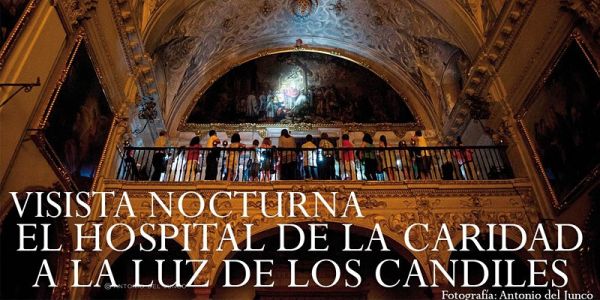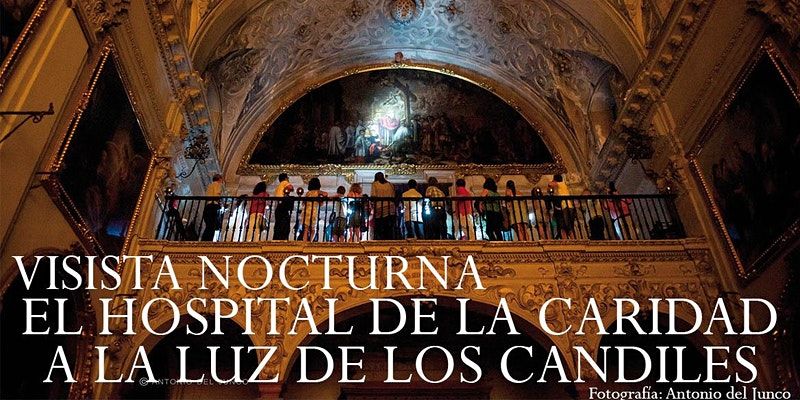Night visit to the Hospital de la Caridad under the lamps
Images
Information
- 10 December 2021, 21:00 Friday
- 6 December 2021, 20:00 Monday
- 4 December 2021, 21:00 Saturday
Description
Since 2013 more than 50,000 people have visited the Hospital de la Caridad con Engranajes Culturales in the light of lamps. In 2021, the Hospital de la Caridad reopens its doors so that the public can enjoy a very particular experience. We will return to visit the Hospital de la Caridad, exclusively, behind closed doors, with small groups and lighting ourselves with lamps to discover spaces closed to ordinary visits and learn about the rites and secrets of one of the most important brotherhoods in the city of Seville. Life and death will be intertwined in a tenuous atmosphere that will flood the church, being able to admire the works of art under the light with which Mañara, Murillo or Pedro Roldán looked at them. As on previous occasions, 50% of the ticket price is allocated to solidarity projects and to the residence of the underprivileged elderly at the Hospital de la Caridad. Participants will discover in an attractive, dynamic and participatory way some of the most important works of art of the Sevillian Baroque, by the light of lamps, with which we want to recreate the original light of the Church at the time when Murillo, Valdés Leal or Pedro Roldán decorated it, in addition you will be able to see for the first time the two great works of Murillo "The multiplication of the Loaves and the fishes" and "Moises in the rock of Horeb" recently restored by the IAPH in their frames and in their place original inside the Church of San Jorge. The visit is structured around three universes: Miguel Mañara: The contempt of the mundane. Who was Miguel Mañara really, what prompted him to build the Hospital de Caridad, or the reason for his contempt for riches and earthly goods will be some of the questions that we resolve in this first block of the visit where we will discover the transformation of the shipyards in hospital and how was the operation of this institution in the seventeenth century. We will take a tour of his life through his personal belongings; his sword, his death mask, the keys to his coffin or the painting: Miguel Mañara reading the Rule of Holy Charity (Valdés Leal, 1681); or the Crucified Christ of Zurbarán. Late: Spirituality, Life and Death in the Baroque. Immersion in the symbolism of the Baroque. Life and death through the works of Valdés Leal, Murillo or Pedro Roldán. Architecture, painting and sculpture will help us to understand the spirit of the Baroque with its vanities and opulences, to reflect on the transience of life and the end of it. We will discover the end of Valdés Leal by the light of lamps, reflecting on the transience of life and the uselessness of hoarding wealth and glory, when only death and oblivion is what remains. Next we will go through the iconographic program designed by Mañara himself and carried out by the most important authors of the Spanish Baroque, Murillo, Valdés Leal and Pedro Roldán: "The miracle of the loaves and fishes" "Moses on the rock of Horeb", (1670-72), Bartolomé Esteban Murillo. “Saint Elizabeth of Hungary curing the tinea pigs” (1670-72) Bartolomé Esteban Murillo. Wall paintings of the dome, Juan Valdés Leal (1678-82) Main Altarpiece: Sculptures made by Pedro Roldán and polychrome by Valdés Leal. "Exaltation of the cross" (Juan Valdés Leal, 1684-1685) The exercise of charity: Myths, Rites and Mysteries of the Brotherhood. What is the Brotherhood of Charity? What are its rites? What are the functions of its brothers? What illustrious brothers have been part of it? What is the purpose of the institution? During the last minutes of the visit we will go up to the noble floor, to discover the exercise of charity and its history. We will visit the Library where there will be books and documents related to Murillo, such as his entry letter to the brotherhood and others referring to his passage through it. We will visit the gallery of famous people with portraits of "Portraits of the Dukes of Montpensier", D. Antonio de Orleans and Doña María Luisa de Borbón or Isabel II. And finally, we will enter the upper Cabildos Room, where in addition to the outstanding eight canvases by Miguel Luna, the only ones preserved by this author, we will be able to contemplate Vision of Constantino (Francisco Herrera “El viejo”, 1614), the only one conserved of all the series of the history of the Holy Cross. The most outstanding piece of the room is the Cross of the executed, Piece that was used to give the extreme unction to the prisoners sentenced to death and that is a piece of the Sevillian school of Pedro Roldán. Organizer: Cultural Gears and Hermandad de la Santa Caridad. Frequent questions How can I contact the organizer if I have questions? info@engranajesculturales.com and 954043851 and 675682212 Should I bring my printed ticket to the event? You can take your ticket in print or on any mobile device Can I update my registration information?
You can update it at any time as long as it is earlier than 1 hour before the start of the activity.
Is it okay if the name on my entry or registration does not match the person who attends?
There is no problem and remember that you can change the data of your entry as many times as you want for free.
T: +34 954 04 38 51
https://www.engranajesculturales.com/



